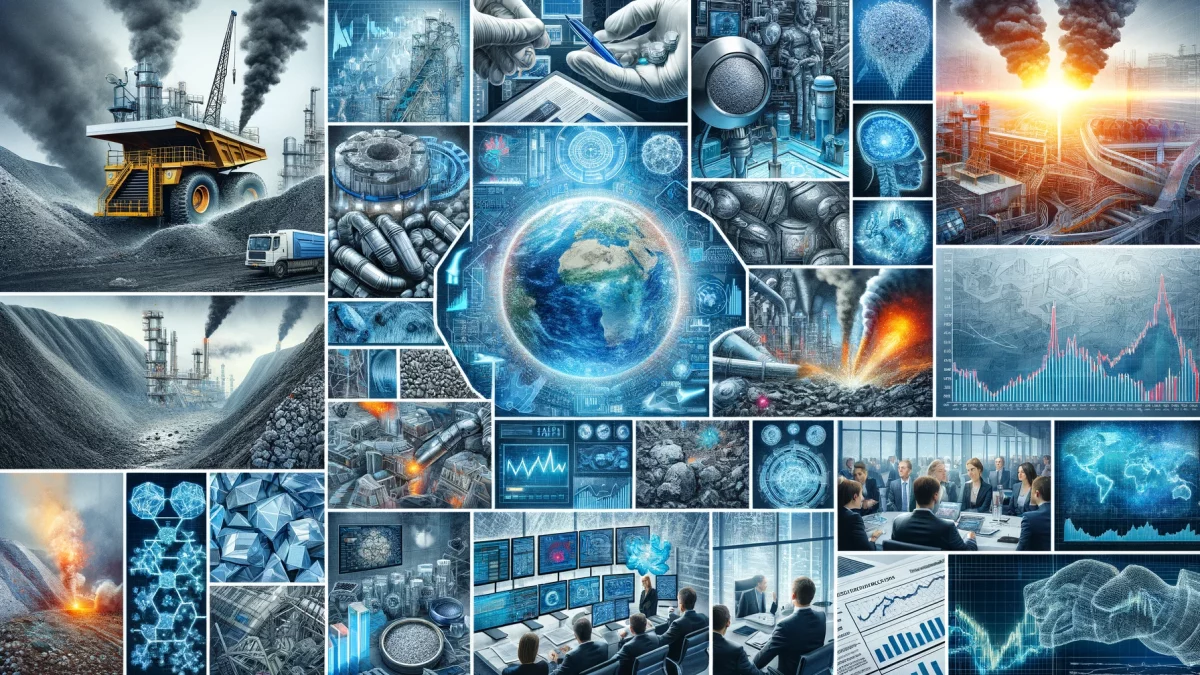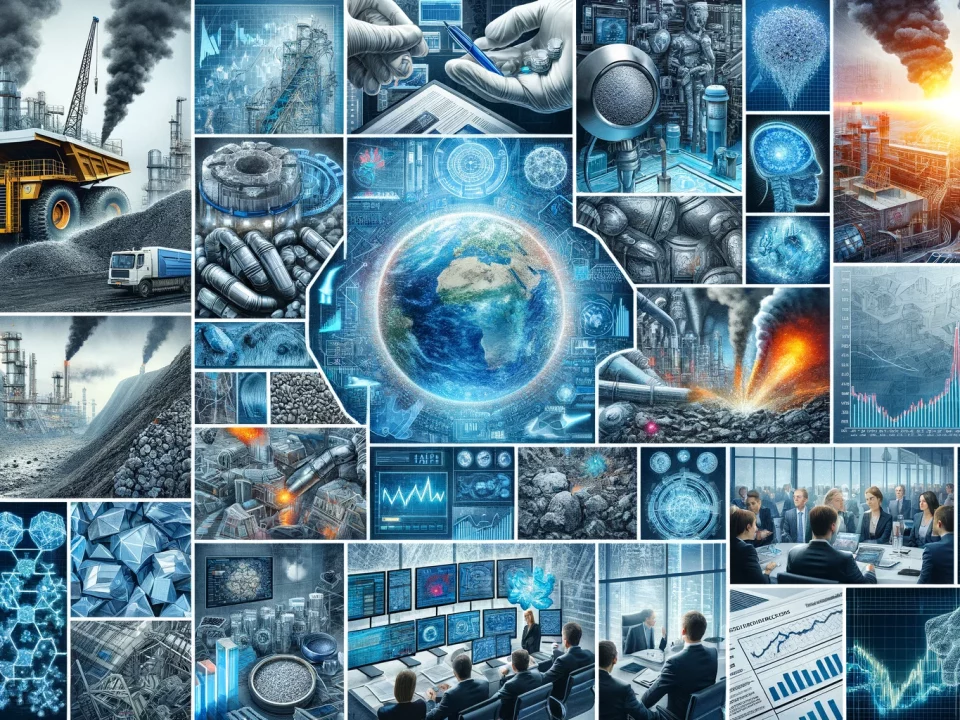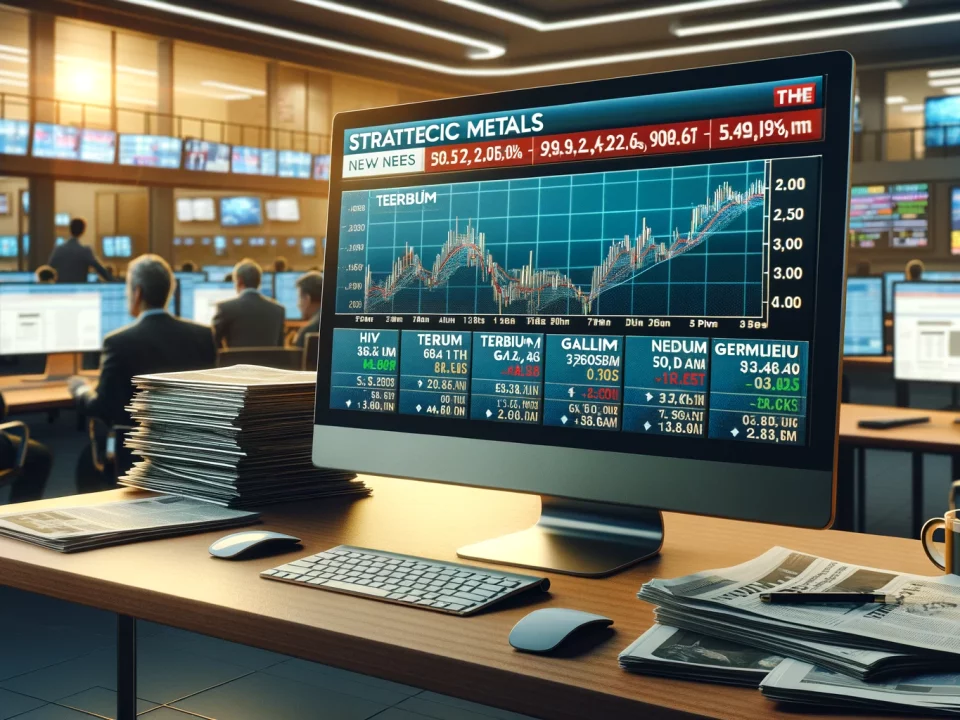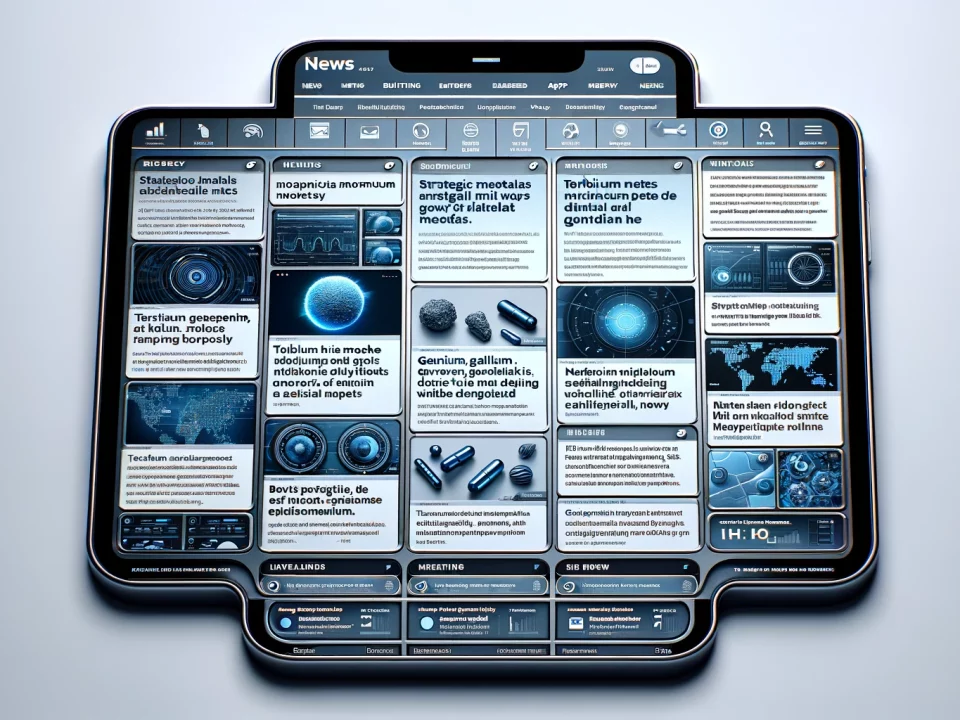
Gallium Prices Up 20% This Year: How Global Demand Is Fueling the Rise
August 27, 2024
Weekly News Review September 2 – September 8 2024
September 8, 2024Welcome to our weekly news review.
UNITED STATES AND PERU SIGN MOU ON STRATEGIC METALS:
Peru has significant reserves of various raw materials.
The US Department of State announced that the United States and Peru have signed a Memorandum of Understanding (MoU) on critical minerals. The signing took place Thursday in Peru’s capital, Lima, during Under Secretary Jose W. Fernandez’s trip throughout South America.
Over the last week and a half, Fernandez visited Argentina, Ecuador, and Peru in search of new sources of critical minerals (we reported). Following the signing of an MoU on critical minerals with his Argentinian counterpart and Ecuador’s entry to the Minerals Security Partnership Forum, Fernandez’s trip ended with the signing ceremony of the MoU in Peru. Under the agreement, the Department said the US and Peru will enhance cooperation on critical mineral supply chains, resource sector governance, investment, and global supply chain security.
According to data from the US Geological Survey (PDF), Peru is the third largest silver producer worldwide, accounting for roughly 12 percent of the total global output in 2023. The member of the Andean community is also the world’s second-largest copper producer, surpassed only by its southern neighbor, Chile. Peru also has significant global gold, lead, tin, and zinc production shares.
EUROPE: 170 APPLICATIONS SUBMITTED UNDER CRMA (CRITICAL RAW MATERIALS ACT) FIRST ROUND:
Numerous companies are applying for recognition as strategic projects.
The European Union wants to bolster its supply of critical raw materials. The Critical Raw Materials Act (CRMA) came into force in May to achieve this. The CRMA stipulates quotas for the extraction, processing, and recycling of a whole range of resources that are “essential for the Union economy and the functioning of the internal market,” according to the legislators’ wording. Projects that contribute to achieving this can benefit from simplified permitting phases and support in accessing funding. A lack of capital and bureaucracy are repeatedly cited as critical challenges for the sector.
APPLICATIONS ALSO INCLUDE SUBMISSIONS FROM OUTSIDE THE EU –
The first round of applications for recognition as “strategic projects” under the CRMA ended last Thursday. The EU Commission has now announced that 170 applications were received by the deadline.
Most of the projects, which range from lithium to rare earth, are focused on the extraction of raw materials (77), with the remainder on further processing (58) and recycling (30), as well as the substitution of certain materials (5). The documents are now being examined and evaluated. It was not disclosed which companies – 49 are not from the EU – have applied for the current round. However, Leading Edge Materials, owner of the Norra Kärr rare earth project in Sweden, and the state-owned Swedish mining group LKAB are among them. The latter wants to develop the Per Geijer rare earth deposit in the country’s north.
An initial list of strategic projects will be presented in December. The deadline for the next round of applications is scheduled for the first quarter of 2025.
AUSTRALIA: ARAFURA SIGNS MOU TO HAVE STRATEGIC METALS PROCESSED IN CANADA –
The Australian miner will work together with the Saskatchewan Research Council.
Australian rare earth mining company Arafura signed a Memorandum of Understanding (MoU) with the Saskatchewan Research Council (SRC) to further refine rare earth material in Canada. Under the MoU, the SRC will refine a mixed middle-heavy rare earth concentrate from Arafura’s Nolan’s project in northern Australia into dysprosium and terbium oxides, essential ingredients to enhance the performance of rare earth magnets.
At Nolan’s, Arafura plans to construct Australia’s first combined mine and processing plant for rare earth, predominantly for the two light rare piles of earth, neodymium, and praseodymium. These two raw materials make up the largest share of ingredients in rare earth magnets besides iron. However, a mixed middle-heavy rare earth concentrate remains during the lengthy refining process. Arafura highlighted that the mixture would have customarily been shipped to China because of limited refining capabilities elsewhere. The global supply of heavy rare earths such as dysprosium and terbium mostly comes from refineries in China processing feedstock from neighboring Myanmar.
Arafura has already concluded purchase agreements for its products with the South Korean car manufacturers Hyundai and Kia, the US conglomerate General Electric, and the Spanish-German wind energy company Siemens Gamesa.
SOUTH KOREA: ANOTHER STEP TOWARDS RARE EARTHS SUPPLY CHAIN –
South Korean state-owned Export-Import Bank and LS Cable plan to cooperate in the domestic production of permanent magnets.
High-tech but low mining: South Korea wants to become less dependent on imports of critical raw materials and has taken a further step in this direction. To strengthen the domestic supply chains for rare earths, the state-owned Export-Import Bank of Korea (Eximbank) wants to cooperate with the Korean cable manufacturer LS Cable & System and its Asia-focused subsidiary LS Eco Energy, as reported by The Korea Herald, among others.
In this context, Eximbank intends to probe the financing of LS Cable’s initiative to establish a value chain for rare earth permanent magnets, which are required for technologies such as wind energy and electromobility. As we reported, the cable manufacturer is planning a new production facility with the German magnet manufacturer Vacuumschmelze for the high-tech components, of which over 90 percent are currently made in China. The Korea Herald writes that LS Cable and its subsidiaries are investing roughly $528 million to ramp up the production of the necessary rare earth alloys.
The newspaper adds that Eximbank plans to launch a new fund in the third quarter of this year to help Korean companies stabilize their supply chains. The fund will be supported by government-guaranteed bonds and endowed with more than $3.7 billion this year.
CHINESE ELECTRIC VEHICLES: CANADA TO IMPOSE 100% TARIFFS –
The Canadian Government will impose import tariffs on Chinese-made electric vehicles, steel, and aluminum.
According to Bloomberg, the levy on EVs will be 100 percent, with steel and aluminum receiving rates of 25 percent each. The measure follows a consultation on potential policy responses to supply chain fears and challenges launched in June. According to CBC, the punitive tariffs on EVs will apply from October 1 and those on steel and aluminum from October 15.
The rates would match similar tariffs imposed by neighboring United States in May. However, the US tariffs hit more goods than the to-be-unveiled Canadian levies, such as semiconductors and solar products. The European Union also recently unveiled tariffs on Chinese-made EVs, albeit with lower rates (we reported). On separate occasions, US President Joe Biden and EU Commission President Ursula von der Leyen spoke of Chinese goods “flooding” world markets through artificially low prices.
EUROPE: EU LAUNCHES RESEARCH PROJECT INTO RARE EARTH MAGNETS –
$9 million in EU funding for GREENE – Hypromag and Robert Bosch among the project partners.
Permanent magnets based on neodymium-iron-boron (NdFeB) are essential for many green technologies. Due to global climate protection efforts, the demand for these high-tech components and the rare earths they contain is rising steadily. At the same time, their production is heavily concentrated in China. The GREENE research consortium, funded with $9 million in EU funds, has been launched to improve Europe’s self-sufficiency.
GREENE (short for SINGLE-GRAIN RE-ENGINEERED Nd-Fe-B PERMANENT MAGNETS) is a four-year project comprising 15 European partners from research and industry, coordinated by the Jožef Stefan Institute in Slovenia. The goal is to develop NdFeB magnets with a minimized overall rare earth content, thereby reducing both import dependence and the environmental impact of extracting these raw materials. In addition to rare earths, Europe also depends on imports for other components, such as boron, 99 percent of which is imported from Turkey. At the same time, the newly designed magnets are expected to be more robust—despite NdFeB magnets already being considered the strongest permanent magnets in the world.
The participating institutions, including Slovenian magnet manufacturer Magnets Ljubljana, Germany-based Robert Bosch GmbH, and the start-up HyProMag, have already collaborated on previous projects such as SUSMAGPRO and REEsilience.
KAZAKHSTAN AND TAJIKISTAN JOIN FORCES ON STRATEGIC METALS:
Kazatomprom and Tajik Rare Metals sign a Memorandum of Understanding.
Kazakhstan and Tajikistan will expand cooperation in the mining and processing uranium, rare metals, and rare earths. Kazatomprom, the world’s largest producer of uranium, and Tajik Rare Metals (Tajredmet), a state-owned enterprise overseeing Tajikistan’s uranium industry’s waste streams, have signed a Memorandum of Understanding (MoU) to this effect. The MoU sets out to establish a strategic partnership between the two Central Asian countries to advance both countries’ mining industries and develop necessary technologies. The MoU was already signed on August 22 during a state visit of Kazakhstan’s President Kassym-Jomart Tokayev to Tajikistan, according to Kazatomprom.
Under the umbrella term rare metals, the two companies encompass metals that occur infrequently in Earth’s crust. For example, Kazatomprom is among the world’s largest tantalum, niobium, and beryllium producers. However, Kazakhstan also plans to mine rare earth elements such as neodymium.
CENTRAL ASIA’S MINERAL WEALTH IS PROMISING FOR COUNTRIES SEEKING TO DIVERSIFY –
Central Asia hosts a large number of rare earth deposits—in 2018, the US Geological Survey compiled a list of 384 occurrences of rare earth element-bearing minerals (PDF). However, the countries mine little. Earlier this year, the Kazakh Minister of Industry and Construction Kanat Sharlapaev announced plans to change this.
Kazakhstan’s mineral potential has long been the focus of countries seeking to diversify supply chains of critical minerals. In 2022, Kazakhstan and the EU concluded a strategic partnership on raw materials and green hydrogen, and the country has since signed multiple deals with EU member states, including France and Germany.
USA: RESEARCHERS WORKING ON “SPONGES” TO SEPARATE RARE EARTH –
Molecular-sized metal-organic frameworks – MOFs – could help search for new critical mineral supply sources.
A team of researchers from Sandia National Laboratories in the United States works on a more straightforward and cleaner way to separate rare earth elements – with synthesized molecular “sponges.” Rare earth elements (REEs) are 17 elements, each with different chemical properties and critical ingredients for many high-tech applications. However, they are difficult to separate from each other, and this involves numerous, highly complicated steps. While REEs are, despite their name, not rare on Earth, downstream processing and separation are highly concentrated geographically and currently dominated by China.
For the last three years, scientists have studied different approaches to separating REEs from each other in water-based mixtures. The team used modified molecules with the technical name metal-organic frameworks, or MOFs. These synthesized miniature “sponges” consist of interchangeable metal hubs and carbon-based rods onto which metal ions can bind. The Sandia team used zirconium and chromium-based MOFs in their research, intending to find ways to selectively “filter out” individual rare earth elements.
The researchers found that tweaking the MOFs’ chemical makeup could enhance their selectivity for different metals. Experiments showed that certain chemical groups improved metal absorption, while computer simulations and X-ray spectroscopy further clarified how these interactions work. While some avenues were ultimately unsuccessful, the team made promising progress in others and hoped that this research could open new possibilities for designing MOFs to separate individual REEs more cleanly and straightforwardly efficiently.
VIETNAM: COOPERATION BETWEEN CHINA RARE EARTH GROUP (CREG) AND VIETNAM –
A high-level meeting will be held between the Vietnamese state asset supervisor and CREG in Hanoi.
Vietnam is regarded as a promising candidate for alternative sources of rare earths to diversify from industry leader China. The ample, mostly untapped resources are estimated to be the second largest worldwide, according to the US Geological Survey (PDF). The Southeast Asian country’s state asset supervisor, the Commission for the Management of State Capital at Enterprises (CMSC), met with Chinese rare earth giant China Rare Earth Group (CREG) this week.
SUSTAINABLE MINING PRACTICES –
Following the meeting, CMSC chairman Nguyen Hoang Anh issued a statement highlighting that the two sides will explore ideas for cooperation to promote the development of mutually beneficial operations in the mining industry. He also added that CREG can run the entire rare earth value chain from exploration to mining and refining, as well as exporting, in a sustainable matter, in line with the Vietnamese Prime Minister’s declaration of July 2023. The Prime Minister then announced that Vietnam would significantly ramp up its rare earth production (we reported). However, he emphasized that only companies working sustainably and with modern technologies would receive mining permits.
The meeting follows a ministerial dialogue held in March 2023 between the CMSC and its Chinese counterpart, the State-owned Assets Supervision and Administration Commission of the State Council (SASAC). During this dialogue, the two countries agreed to intensify cooperation in industry and energy-related fields, among other areas.
CREG was formed in 2021 amid a decade-long consolidation in the Chinese rare earth industry and accounts for the majority of activities in the sector in China’s south (we reported). SASAC also holds a 30 percent stake in the company.
EUROPE : NEW RULES NEEDED REGARDING MINING WASTE –
Too inconsistent, too uncertain: Transport & Environment calls for an update to outdated standards.
By 2030, ten percent of the European Union’s demand for certain raw materials required for the energy transition and digitalization is set to come from domestic mining, according to the Critical Raw Materials Act (CRMA), the new raw materials legislation of the EU. However, mining in Europe has been declining for decades, and the existing regulations are not up to the challenges posed by the CRMA—at least according to an analysis by Transport and Environment (T&E), a non-governmental organization focused on sustainable mobility.
According to the analysis, an update is especially needed regarding the regulations on mining waste, specifically the EU Extractive Waste Directive of 2006. The study concludes that countries like China and Brazil have stricter laws, even though Europe’s environmental and social standards are often considered among the highest in the world.
A major issue is the significant fragmentation, with much left to the discretion of member states, leading to unclear responsibilities in cases of accidents or damage. It is also not guaranteed that the best and safest technologies for storing and monitoring mining waste are used. The authors also criticize local communities’ need for more information and process involvement.
Considering these points, T&E demands that the EU Commission revise the Extractive Waste Directive. The revision should be based on the Safety-First guidelines developed by global mining experts, civil society representatives, and scientists. These guidelines include annual emergency and evacuation drills, consideration of financial risks, and consultation with affected communities by independent technical experts. Additionally, the opportunity should be taken to integrate rules for using mining residues to utilize valuable resources more efficiently.
AUSTRALIA: LYNAS REPORTS SETBACKS AND PROGRESS –
Australian rare earth company reports a 72.2 percent drop in profits.
Australian rare earth mining company Lynas has reported a significant decline in profits for the 2024 fiscal year. After earning $ 211 million in 2023, the company disclosed a profit of only $57 million for 2024. Despite this sharp decrease, the results still exceeded analysts’ expectations, according to Reuters, among others.
The profit decline—over 70 percent—is attributed to a challenging market environment, including low demand in China and currently lower prices for rare earths. However, CEO Amanda Lacaze noted that there have been positive developments since May. She also highlighted the company’s progress during the fiscal year, such as commissioning a processing plant in Australia that produces mixed rare earth carbonate, which is then sent to Malaysia for further processing. Lynas also operates a refinery there.
The company is working on a similar facility in Texas, where initial groundwork was expected to begin this year. However, issues related to wastewater management have arisen, and resolving them likely won’t happen in 2024, leading to potential delays, according to the annual report.
Meanwhile, there have yet to be any updates on the merger talks with US company MP Materials, which were first speculated in February and later confirmed by Lynas. In an interview with Bloomberg, Lacaze reiterated that no agreement was reached with the operator of the Mountain Pass mine.






